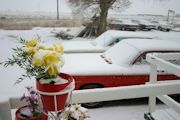ALUMINUM - Dealing With A Significant Difference In Corvair Engines
Most engines manufactured in the 1960s were made from steel and cast iron. Corvairs were different... Most of the engine is constructed from aluminum castings. This material is relatively soft and fragile when compared to the normal materials used in engines, and working on a Corvair engine requires some different techniques. Here are a few tips:
When assembling a Corvair engine, always be careful when you are screwing a bolt into aluminum. It is easy to cross-thread a bolt and damage the soft aluminum threads. Screw the bolt in by hand, and then finish by tightening carefully with a wrench. Use of anti-seize compound on the threads will help in later removal of bolts from aluminum. Use a torque wrench and torque to the proper value listed in the factory service manual whenever possible, to avoid over-tightening the bolt and possibly damaging the soft aluminum threads
By the way, using anti-seize compound on spark plugs to protect the soft aluminum threads in the cylinder heads is probably NOT a good idea. The anti-seize compound may act like an insulating material between the spark plug and the head, causing the spark plug to run hotter than its designed temperature rating. Just carefully screw each spark plug into the head by hand, using the spark plug socket and extension only. Once the spark plug "bottoms out", then add a torque wrench and tighten to the proper torque, using caution not to strip the cylinder head spark plug threads!
This topic is debatable, however. The dissimilar metal contact between steel (spark plug) and aluminum (head) can be a problem. Damage to the head can occur when removing the plug from an aluminum head, and many mechanics swear by the practice of using anti-seize compound with spark plugs in aluminum heads. The recommendation seems to be to use just a trace on the threads.
Permatex 80078 Anti-Seize Lubricant with Brush Top Bottle, 8 oz.
Product Features
- Highly refined blend of aluminum, copper and graphite lubricants
- Salt, corrosion and moisture resistant, this lubricant is ideal for marine use
- Prevents galling, corrosion and seizing and to assure easier disassembly
- Suggested Applications: For easy removal of spark plugs, cylinder head and exhaust head bolts
- Temperature range: -60F to 1600F
However, here is some additional spark plug info from NGK, for your consideration:
NGK Spark Plugs (U.S.A.), Inc. – Aftermarket Division
46929 Magellan Drive - Wixom, Michigan 48393
Tech Bulletin -
Anti-Seize Compounds on Spark Plug Threads
Topic
The use of anti-seize compounds on spark plug threads that have a metal shell plating (i.e. Zinc or Nickel plating).
Issue
Applying anti-seize to the threads of spark plugs that have a metal plating allows the installer to mistakenly over-tighten the spark plug in the cylinder head; This stretches and fatigues the threads of the spark plugs, causing a much higher probability that the plug will break during installation or in some cases upon removal.
Solution
For spark plugs with special metal plating simply do not use anti-seize on initial installation; All NGK Spark Plugs are manufactured with a special trivalent Zinc-chromate shell plating that is designed to prevent both corrosion and seizure to the cylinder head; Thus eliminating the need for any thread compounds or lubricants.
Additional Information
NGK recommends only using spark plugs with metal plating on all aluminum head applications to prevent damage to the head and plug. Metal shell plating acts as a “lubricant” which breaks away from the main body of the spark plug during removal, preventing damage to the spark plug and or threads in the cylinder head.
Summary
All spark plugs that have a blackened or dull appearance on the metal body offer no protection against seizing or bonding to the cylinder head and so it is with these spark plugs that anti-seize would be required. A spark plug that has a shiny silver appearance on the metal body usually indicates that the plug is manufactured with metal shell plating and therefore will not require anti-seize.
As you dismantle the engine, box, bag and tag all the parts and pieces so you don't lose anything. If you don't already have a factory shop manual, by all means buy a copy! If you plan to reuse the hydraulic lifters, tag them so they go back in the original holes to match up with the original cam lobes. It helps to be organized, which you will appreciate when it comes time to put it all back together!
A bottle of Anti-seize compound is $7.49 on Amazon.com. It lasts a long time. I bought a bottle in 1969 when I rebuilt my first Corvair engine. I still have that bottle and haven't used it up yet!
http://www.amazon.com/Permatex-80078-An ... anti+seize
My 44+ year-old can of Anti Seize Compound.

 1966 Corvair Corsa Convertible
1966 Corvair Corsa Convertible
